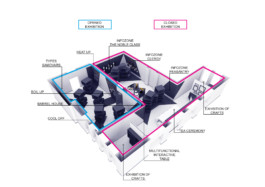Exposition of "Life and manners of Russia in 18–19 centuries."
The exhibition presents a collection of more than 300 items of rural and urban life. The main accent of the exposition is an integral part of the culture of the Russian Empire and later period, the most recognizable symbol of Russian tea-drinking - samovars.
The samovar occupied an honourable place in rich and poor houses, it was a representative object of all classes. The samovar becomes a "talking" object, which can tell a lot about the era of its golden age.
The samovar is a complex sculptural and jewelry object with many details.
The main task of the exposition was the creation of an individual visual space for each unique exhibit within a relatively limited area of the museum.
The main element of the demonstration of samovars was a modular four-sided display case with internal lighting. Display Modules have different overall dimensions for the exposure of different typologies of samovars. The showcase has a simple shape, which is enhancing complexity and beauty of the samovar and creates an independent perception space for each exhibit. Restrained external lighting and bright interior illumination of the module allow to avoid glare on the glazing, a homogeneous dark background behind samovars will allow to reveal the details of the artifact.
Another integrative part of the exhibition is a series of informational interactive components, where on multi-sensorial way the histories and visuals associated with the main theme of the exhibition are presented.
Also, the exposition provides space for discussions and tee-ceremony as a final highlights for the visitors.
Status
Completed project. Opened 2016
Location
Kirovsk
References
Project made in collaboration with a MadiaVision, St. Petersburg








